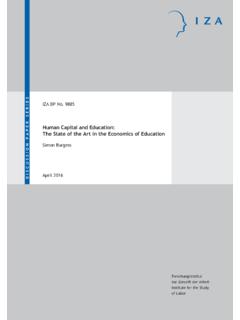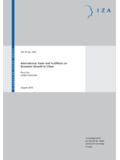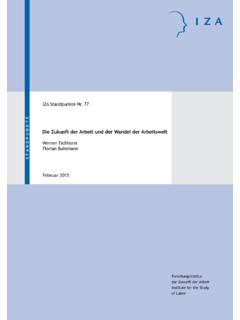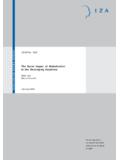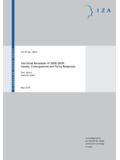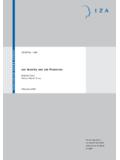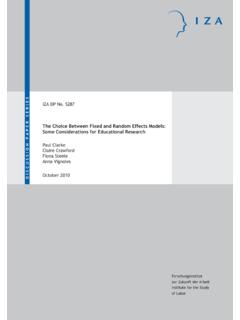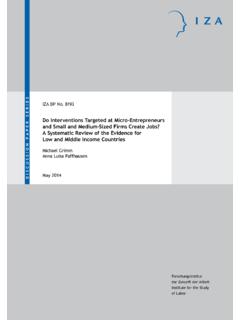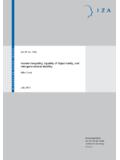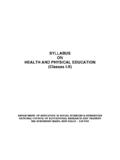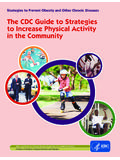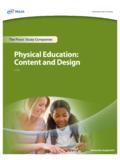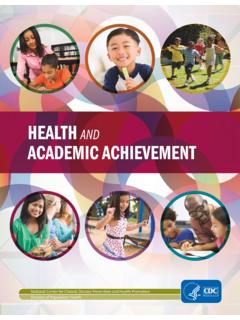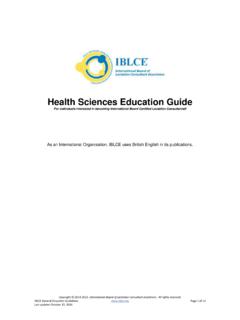Transcription of The Impact of Physical Education on Obesity among ...
1 SERIES. IZA DP No. 6807. PAPER. The Impact of Physical Education on Obesity among elementary School Children John Cawley DISCUSSION. David Frisvold Chad Meyerhoefer August 2012. Forschungsinstitut zur Zukunft der Arbeit Institute for the Study of Labor The Impact of Physical Education on Obesity among elementary School Children John Cawley Cornell University and IZA. David Frisvold Emory University Chad Meyerhoefer Lehigh University Discussion Paper No. 6807. August 2012. IZA. Box 7240. 53072 Bonn Germany Phone: +49-228-3894-0. Fax: +49-228-3894-180. E-mail: Any opinions expressed here are those of the author(s) and not those of IZA. Research published in this series may include views on policy, but the institute itself takes no institutional policy positions. The Institute for the Study of Labor (IZA) in Bonn is a local and virtual international research center and a place of communication between science, politics and business.
2 IZA is an independent nonprofit organization supported by Deutsche Post Foundation. The center is associated with the University of Bonn and offers a stimulating research environment through its international network, workshops and conferences, data service, project support, research visits and doctoral program. IZA engages in (i). original and internationally competitive research in all fields of labor economics, (ii) development of policy concepts, and (iii) dissemination of research results and concepts to the interested public. IZA Discussion Papers often represent preliminary work and are circulated to encourage discussion. Citation of such a paper should account for its provisional character. A revised version may be available directly from the author. IZA Discussion Paper No. 6807. August 2012.
3 ABSTRACT. The Impact of Physical Education on Obesity among elementary School Children 1. In response to the dramatic rise in childhood Obesity , the Centers for Disease Control (CDC). and other organizations have advocated increasing the time that elementary school children spend in Physical Education (PE) classes. However, little is known about the effect of PE on child weight. This paper measures that effect by instrumenting for child PE time with state policies, using data from the Early Childhood Longitudinal Study, Kindergarten Cohort (ECLS-K) for 1998-2004. Results from IV models indicate that PE lowers BMI z-score and reduces the probability of Obesity among 5th graders (in particular, boys), while the instrument is insufficiently powerful to reliably estimate effects for younger children. This represents some of the first evidence of a causal effect of PE on youth Obesity , and thus offers at least some support to the assumptions behind the CDC recommendations.
4 We find no evidence that increased PE time crowds out time in academic courses or has spillovers to achievement test scores. JEL Classification: I12, I18, I21, H75, K32. Keywords: Obesity , Physical activity, Physical Education , children, health Corresponding author: John Cawley 3M24 Martha Van Rensselaer Hall Cornell University Ithaca, NY 14853. USA. E-mail: 1. We gratefully acknowledge financial support from the Robert Wood Johnson Foundation, the Emory Global Health Institute, and a Faculty Research Grant from Lehigh University. We thank Griffin Edwards and John Zimmerman for research assistance. For helpful comments, we thank Charles Courtemanche, Inas Rashad Kelly, seminar participants, and conference participants at the American Economic Association annual meeting, American Society of Health Economics biennial meeting, NBER Health Economics program Spring meeting, and the Southern Economic Association annual meeting.
5 Introduction The prevalence of Obesity among elementary schoolchildren in the United States nearly quadrupled between 1965 and 2000 (Ogden et al., 2002).2 As of 2009-2010, of American youths aged 6-11 years are overweight, and are obese (Ogden et al., 2012). The Surgeon General has declared childhood Obesity to be an epidemic with significant adverse health consequences, including vascular disease and Type 2 diabetes ( , 2010), that significantly raise health care costs for youth (Trasande and Chatterjee, 2009; Trasande, Liu, Fryer et al., 2009). The Surgeon General attributes the rise in childhood Obesity , in part, to school cutbacks in Physical Education (PE) and urges all school systems to mandate daily PE that totals at least 150 minutes per week for elementary schoolchildren ( , 2010). Other organizations concur, including the American Academy of Pediatrics (AAP), Centers for Disease Control and Prevention (CDC), Institute of Medicine (IOM), and National Association of State Boards of Education (NASBE) (see, , IOM, 2012; AAP, 2006).
6 However, as of 2006, only of elementary schools were in compliance with the recommendation of 150 minutes of PE. per week (Lee et al., 2007). Despite the recommendations of the Surgeon General, CDC, and others, there is little evidence of a causal effect of PE on youth Obesity . There are several reasons that additional PE. may not lower weight or the risk of Obesity . First, PE classes may not involve much Physical activity. Several studies have used direct observation or accelerometers to measure the amount of time that students spend physically active during PE; they conclude that elementary schoolchildren spend only 9-42% of PE time engaged in moderate to vigorous Physical activity 2. For children, overweight is defined as a body mass index (BMI) above the historic 85th percentile of the BMI. distribution for youth of the same age and gender, and Obesity is defined as a BMI above the historic 95th percentile (Barlow et al.)
7 , 2007). BMI is calculated as weight in kilograms divided by height in meters squared. 2. (Pate et al., 2011). A second issue is that students may offset any additional Physical activity during PE by decreasing Physical activity outside of school, with little net Impact on Physical activity or weight. This paper contributes to the literature by estimating the causal effect of PE time on the weight of elementary schoolchildren. A large number of studies have reported the correlation of PE with student weight (see Pate et al., 2011, for a review). However, the correlation may be a badly biased estimate of the causal effect for several reasons. First, if enrollment is optional then there may be selection bias; physically fit students may be more likely to enroll. Second, the amount of required PE and enrollment in PE in a school may be correlated with the area's socioeconomic status (SES); higher-SES schools may require more PE, or may offer more or better PE courses, and may also have more physically fit students because of their higher SES.
8 Alternatively, higher-SES schools may devote more time to academic subjects and less to PE. A small number of studies estimate the causal effect of PE on youth Cawley, Meyerhoefer, and Newhouse (2007) estimate the effect of PE time on the Physical activity and weight of high school students, using variation in PE requirements across states as an instrument. Their IV models indicate that PE increases self-reported Physical activity but has no detectable effect on the weight of high school students. Datar and Sturm (2004) study the effect of the increase in PE that results from progression from kindergarten to first grade, and find that an additional hour of PE time per week is associated with lower BMI in overweight or obese girls, but results in no change in BMI for healthy weight girls or for boys. This paper examines the effect of PE on elementary schoolchildren (specifically, those in kindergarten through fifth grade).
9 We analyze data from the Early Childhood Longitudinal 3. There are also studies that involved randomized experiments of innovative PE curricula (for reviews, see Katz, 2009; Brown and Summerbell, 2008), but these studies are not informative about the effect of PE as it currently exists. 3. Study, Kindergarten Cohort (ECLS-K). Our methods for identifying causal effects are described in the next section. Methods and Data The objective of this paper is to measure the causal effect of PE time on the weight of elementary schoolchildren. If PE time was randomly assigned, then one could regress child weight W on time spent in PE (PE), controlling for a vector of relevant observables X: . and interpret the coefficient on PE time, , as the causal Impact of PE on weight. However, PE time is not randomly assigned.
10 Physically fit students may be more likely to choose PE, and the PE requirements and offerings of individual schools may be correlated with local SES. As a result, the error term is likely correlated with the regressor of interest PE, and thus an OLS estimate of the coefficient of interest is likely biased. In order to measure the causal Impact of PE on weight, one needs to find a natural experiment that creates exogenous variation in PE time without directly affecting student weight ( the instrument should be highly correlated with PE but uncorrelated with ). The natural experiment that we exploit is variation across states and over time in state requirements for PE. for elementary schoolchildren. Using these state policies as instruments, we estimate models of instrumental variables in order to measure the causal effect of PE time on child weight.
